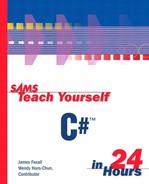Summary
In this hour, you learned all about objects. You learned how objects have properties, which are attributes that describe the object. Some properties can be set at design time using the Properties window, and most can also be set at runtime in C# code. You learned that referencing a property on the left side of the equal sign has the effect of changing a property, whereas referencing a property on the right side of the equal sign retrieves the property's value.
In addition to properties, you learned that objects have executable functions, called methods. Like properties, methods are referenced by using a “dot” at the end of an object reference. An object may contain many methods and properties, and some properties can even be objects themselves. You learned how to “follow the dots” to interpret a lengthy object reference.
Objects are often used as a group, called a collection. You learned that a collection often contains properties and methods, and that collections let you easily iterate through a set of like objects. Finally, you learned that the Object Browser can be used to explore all the members of an object in a project.
The knowledge you've gained in this hour is fundamental to understanding programming with C#, because objects and collections are the basis on which applications are built. After you have a strong grasp of objects and collections—and you will have by the time you've completed all the hours in this book—you'll be well on your way to fully understanding the complexities of creating robust applications using C#.
